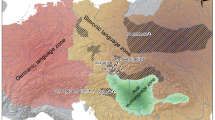Abstract
This article analyzes the 2002 Coretta Scott King Award book by Mildred Taylor entitled The Land. The novel and its author are situated within a tradition of historical fiction written by and about African Americans. I then offer an analysis that utilizes Critical Race Theory as an interpretive tool for examining the ways Taylor embeds meanings of land ownership into the novel. In particular the following themes emerged: (1) inspiration and adoration, (2) entitlement and privilege, and (3) freedom and security. The conclusion addresses the importance of applying Critical Race Theory to literary studies as well as identifying ways to purposefully incorporate African American young adult historical fiction within today’s classrooms.
Similar content being viewed by others
References
Adoff, Jaime. Jimi & Me. New York: Jump at the Sun, 2005.
Bader, Barbara. “How the Little House Gave Ground: The Beginnings of Multiculturalism in a New, Black Children’s Literature.” The Horn Book Magazine. (2002). 657–673.
Bell, Derrick. “Who’s Afraid of Critical Race Theory?” University of Illinois Law Review. 95:4 (1995). 893–910.
Bishop, Rudine Sims. Free Within Ourselves: The Development of African American Children’s Literature. Westport, CT: Greenwood P, 2007.
Brooks, Wanda. “Reading Representations of Themselves: Urban Youth Use Culture and African American Textual Features to Develop Literary Understandings.” Reading Research Quarterly. 41 (2006). 372–393.
Brown, Jennifer. “Stories Behind the Book: The Land.” Publishers Weekly 24 Oct. 2001: 24–27.
“Censorship Roundup.” School Library Journal 22 Mar. 2004.
Curtis, Christopher Paul. The Watsons Go to Birmingham-1963. New York: Delacorte, 1995.
Curtis, Christopher Paul. Elijah of Buxton. New York: Scholastic, 2007.
Davis-Undiano, Robert. “Mildred D. Taylor and the Art of Making a Difference.” World Literature Today May–Aug. (2004). 11–13.
Delgado, Richard. Ed. Critical Race Theory: The Cutting Edge. Philadelphia: Temple University Press, 1995.
Draper, Sharon. Copper Sun. New York: Simon and Schuster, 2006.
Franzak, Judith. “Hopelessness and Healing: Racial Identity in Young Adult Literature.” The New Advocate. 16 (2001). 43–56.
Hamilton, Virginia. Anthony Burns: The Defeat and Triumph of a Fugitive Slave. New York: Knopf, 1988.
Harris, Cheryl. “Whiteness as Property.” Harvard Law Review. 106: 8 (1993). 1707–1791.
Harris, Violet. “African American Children’s Literature: The First One Hundred Years.” Journal of Negro Education. 59 (1990). 540–555.
Harris, Violet. “Children’s Literature Depicting Blacks.” Using Multiethnic Literature In the K-8 Classroom. Ed. Violet Harris. Norwood, MA: Christopher Gordon, 1997. 22–58.
Johnson, Dianne. “A Tribute to Mildred Taylor.” World Literature Today May–Aug. (2004). 4.
Ladson-Billings, Gloria, and Tate, William. “Toward a Critical Race Theory of Education.” Teachers College Record. 97 (1995). 47–69.
Lester, Julius. Day of Tears: A Novel in Dialogue. New York: Hyperion, 2005.
Lynn, Marvin, and Adams, Maurianne. “Introductory Overview to the Special Issue Critical Race Theory and Education: Recent Developments in the Field.” Equity & Excellence in Education. 35 (2002). 87–92.
Martin, Michelle. “Exploring the Works of Mildred Taylor: An Approach to Teaching the Logan Family Novels.” Teaching and Learning Literature. 7: (3) (1998). 5–13.
McNair, Jonda. “A Comparative Analysis of The Brownies’ Book and Contemporary African American Children’s Literature Written by Patricia C. McKissack.” Embracing, Evaluating and Examining African American Children’s and Young Adult Literature. Eds. Wanda Brooks, and Jonda McNair. Lanham, MD: The Scarecrow Press, 2008. 3–29.
Moller, Karla, and Allen, JoBeth. “Connecting, Resisting, and Searching for Safer Places: Students Respond to Mildred Taylor’s The Friendship.” Journal of Literacy Research. 32 (2000). 145–186.
Moss, Anita. “Mildred D. Taylor.” Writers of Multicultural Fiction for Young Adults. Ed. M. Kutzer. Westport, CT: Greenwood Press, 1996. 401–413.
Myers, Walter. Fallen Angels. New York: Scholastic, 1988.
Myers, Walter. The Glory Field. New York: Scholastic, 1994.
Pinkney, Andrea. Hold Fast to Dreams. New York: Morrow, 1995.
Smith, John. “The Enduring Myth of Forty Acres and a Mule.” The Chronicle of Higher Education. 39 (2003). B11 & F24.
Sutherland, LeeAnn. “Black Adolescent Girls’ Use of Literacy Practices to Negotiate Boundaries of Ascribed Identity.” Journal of Literacy Research. 37 (2005). 365–406.
Taylor, Mildred. Roll of Thunder Hear My Cry. New York: Puffin, 1976.
Taylor, Mildred. “Acceptance Speech for the 1997 Alan Award.” The ALAN Review (1998): 8 pars. August 29, 2007. http://scholar.lib.vt.edu/ejournals/ALAN/spring98/.
Taylor, Mildred. The Land. New York: Penguin, 2001.
“Teachers’ Top 100 List”. Reading Today (Feb/March Issue). (2008). 40.
Author information
Authors and Affiliations
Corresponding author
Additional information
In this article, the ownership of land as property is foregrounded although the term “property” is both literally and metaphorically understood in Critical Race scholarship (Harris 1993).
Rights and permissions
About this article
Cite this article
Brooks, W. An Author as a Counter-Storyteller: Applying Critical Race Theory to a Coretta Scott King Award Book . Child Lit Educ 40, 33–45 (2009). https://doi.org/10.1007/s10583-008-9065-9
Received:
Accepted:
Published:
Issue Date:
DOI: https://doi.org/10.1007/s10583-008-9065-9



